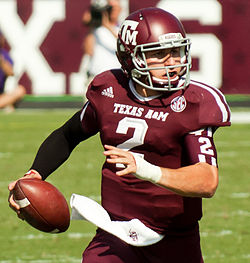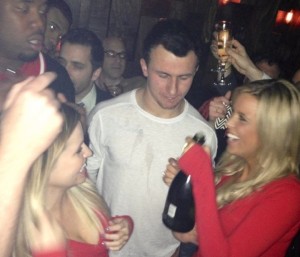 The Saga of Johnny Manziel – AKA Johnny Football
The Saga of Johnny Manziel – AKA Johnny Football
Imagine working for a company for three or four years in your early twenties. Now imagine working for that same company which controls the use of your name and likeness while you are an employee. If you use your name or likeness for your own profit, you would be in violation of company policy which may cause you to be suspended or fined. If you wanted to become the face of your own start-up business while still working at this company, you would be in violation. If you wanted to write an autobiography with your name and picture on the front cover, you would be in violation. If you wanted to advertise your band’s new single on iTunes, you would be in violation.
Sounds a little ridiculous, right? Well the National Collegiate Athletic Association (NCAA) doesn’t seem to think that policy is ridiculous. In fact, NCAA bylaw 12.5.2.1, states that student-athletes cannot allow their names or likenesses to be used for commercial purposes, including to advertise, recommend or promote sales of commercial products, or accept payment for the use of their names or likenesses. In short, student-athletes cannot be paid for anything that involves their own name or image. This bylaw is nothing new for student-athletes to find themselves in trouble with. Within recent memory, former Ohio State quarterback Terrelle Pryor and four of his teammates were suspended five games for selling championship rings, jerseys, and awards. Pryor stated that he had family issues that caused him to seek a profit for his championship rings and other memorabilia. University of Minnesota wrestler, Joel Bauman, was ruled ineligible for the remainder of the 2012 -2013 season because he refused to use an alias for his positive hip-hop song that can be purchased on iTunes.
Fast forward to the present, Johnny Manziel is under heavy allegations for violating NCAA bylaw 12.5.2.1 by accepting payment from autograph broker, Drew Tieman, in exchange for signed footballs, pictures, and helmets. The NCAA is currently investigating these allegations of Johnny Manziel. Manziel could be ruled ineligible for part of the upcoming season depending on how the NCAA’s investigation unfolds. If the NCAA finds that Manziel has violated bylaw 12.5.2.1 multiple times with various autograph brokers, that could warrant a greater punishment than if Manziel knew the memorabilia was going on sell, but did not directly profit from the transaction. As John Infante, a former Division I compliance officer, mentions: precedence for violations that exceeded $1000 usually warrants a suspension of at least 30 percent of the football season (4 games). The allegations so far state that Johnny Football was paid about 7,500 dollars, which is more than enough to warrant a suspension for 30 percent of the season, and possibly more. Texas A&M has hired Lightfoot, Franklin and White, the same law firm Auburn University hired to protect Cam Newton‘s eligibility during the 2010 College Football season. Hiring Lightfoot, Franklin and White gives some indication that Texas A&M will fight for Manziel’s eligibility and hope he is able to remain eligible like Newton.
 Many people are in uproar over Johnny Manziel’s actions, but I am left wondering why? Maybe it’s because he is a Heisman Trophy winner who is suppose to know better. Maybe it’s because he comes from a wealthy family who isn’t in need of money like Terrelle Pryor’s family was at the time of his violation. As I see it, Johnny Manziel’s alleged actions are what most 20-year old college students would do or consider. College students often make decisions that may not be the best at that time, but it allows them to grow and learn from those decisions. Instead of condemning Johnny Manziel, we should be condemning the NCAA and its bylaws, which are one-sided and unfair to student-athletes.
Many people are in uproar over Johnny Manziel’s actions, but I am left wondering why? Maybe it’s because he is a Heisman Trophy winner who is suppose to know better. Maybe it’s because he comes from a wealthy family who isn’t in need of money like Terrelle Pryor’s family was at the time of his violation. As I see it, Johnny Manziel’s alleged actions are what most 20-year old college students would do or consider. College students often make decisions that may not be the best at that time, but it allows them to grow and learn from those decisions. Instead of condemning Johnny Manziel, we should be condemning the NCAA and its bylaws, which are one-sided and unfair to student-athletes.
Former college basketball player and ESPN college basketball analyst Jay Bilas agrees that there are inequalities within the NCAA system that need to be address. These inequalities include student-athletes use of their own name and image, which he tweeted about recently. Bilas took to Twitter to show how the NCAA’s merchandise website is used to profit from the image of student-athletes (even those whom have been suspended) while student-athletes aren’t allowed to profit from their own name, image or likeness.
This article is not to make an argument for paying student-athletes for their own name, image, or likeness. That issue is currently being argued in court. Nor is this an article to argue why college scholarships aren’t just compensation for student-athletes. Rather, this article is to show the inequality in some NCAA bylaws and the need to reform those bylaws. It’s justified when the NCAA makes billions off of its student-athletes, but when those same student-athletes try to profit off of themselves, the NCAA plays the victim and punishes the wrongdoer. Just imagine if the company you work for auctioned off a signed photograph of you to build a new break room in the company’s building. However, it would be impermissible for you to auction off that same photograph in order for you to buy a house. Does that seem just?
The NCAA is a multi-billion dollar association that profits significantly because of its student-athletes. It’s time for the NCAA to reform its bylaws to properly accommodate student-athletes within this multi-billion industry. It’s time to start holding the President and executives of the multi-billion association more accountable than 20-year old student-athletes.
Comment below, like Sports Networker on Facebook and follow us on Twitter @SportsNetworker



Despite most of us in the athletic community not agreeing with the NCAA’s rules relative to paying student athletes, and their not being able to profit from the use of their name, photographs, etc., by their respective school and / or the NCAA in promoting their athletic program(s), the student athlete is also receiving: a.) a great education…and at a Major College / University…the costs of which would be in the $60K-$75K or more per year…and for a (5) red-shirt athlete…well in excess of a Quarter of a Million Dollars in free education (room and board), and b.) If that same student athlete becomes one of the few, very fortunate athletes who becomes successful as an athlete, and they then sign a professional contract…perhaps worth $10MM or more…then c.) that student athlete has succeeded well beyond just receiving a great education.
We can argue all we want, but as long as there is an NCAA, and they are allowed (by the schools) to remain as powerful as they are…because of Television Contracts, etc., with the Major Networks, then Student Athletes will remain, non-paid, student athletes, who help bring in major revenue to their respective college / university.
Until the schools, television networks, and sponsors band together in behalf of the student athletes (and that’s not going to happen anytime soon), it’s going to remain “as-is”.
Any athlete that is foolish enough to risk it all for a payday today by ignoring the NCAA Rules, may have to suffer the consequences long term…it just goes to show that they didn’t deserve the scholarship anyway, as they were too stupid in the first place, to think they could get away with not being caught. The mentoring of a college coach, parents, etc., was all a waste in the first place. If they claim they didn’t understand the rules, they shouldn’t have been allowed to enter college or a university….and high school junior or senior would already be savvy to those rules.
Hiya. I found your blog the use of msn. That is the very well composed report. I will be likely to bookmark the item as well as go back to understand extra of this information. Was looking for posting. I’m going to undoubtedly come back.